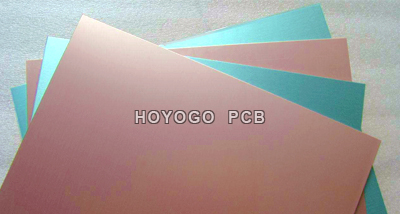The basic material of PCB board is called base material, also called copper clad laminate. Components will generate heat when working, so the material of the PCB board must have the characteristics of heat resistant. Even if there is a fire, it must have the characteristics of being able to extinguish itself. So how to choose PCB copper clad laminate?

This degree of flame resistance is divided into grades, which can be divided into FR-1 to FR-5. The most commonly used one is grade FR-4 epoxy fiberglass cloth copper clad laminate, which is split into a "sandwich" structure, with copper foil on top and bottom and a prepreg in the middle. Among them, prepreg is commonly known as adhesive pad. It is made by drying fiberglass cloth through a gluing machine to the "B" stage, that is, the prepreg is in a soluble and meltable state and will be used to directly press copper clad laminates.
Choosing copper clad laminates of different material is just like how we usually choose mobile phones, we need to look at running memory, flash memory, CPU, refresh rate, etc. The parameters of the copper clad laminate are glass transition temperature (Tg), dielectric constant, and coefficient of thermal expansion (CTE).
1. Glass transition temperature Tg value
The glass transition temperature Tg value can be generally understood as the temperature resistance level. At present, ordinary FR-4 boards are generally between 130 and 140 degrees. If the user's demand exceeds this range, it can be optimized through resin formula and other solutions, and the Tg value can be increased to about 160~200 degrees. Of course, the cost will also increase accordingly.
2. Dielectric constant
The higher the level of the product, the denser the traces on the PCB. When the frequency of transmitted signals is high, crosstalk easily occurs between lines, affecting the quality of signal transmission. Therefore, if you choose a copper clad laminate with a lower dielectric constant, the corresponding high-speed signals transmission effect will be better.
3. Coefficient of thermal expansion (CTE)
The coefficient of thermal expansion (CTE) is also a very important indicator. The larger the area of the PCB board, the easier it is to expand and deform during the subsequent high-temperature SMT process. Thermal expansion deformation can be solved by modifying the resin in the copper clad laminate, or by reducing the proportion of resin content. It should be noted that doing so will reduce the electrical insulation and chemical properties of the copper clad laminate.
In addition to the commonly used FR-4 materials, there are other different PCB base material. According to the reinforcement materials, they include paper substrates, composite substrates, metal substrates, ceramics, etc. HoYoGo can customize PCB of various materials for customers. If you have relevant needs, please send us an inquiry.